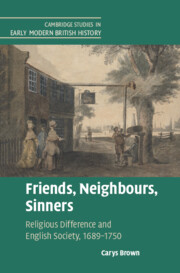Book contents
- Friends, Neighbours, Sinners
- Cambridge Studies in Early Modern British History
- Friends, Neighbours, Sinners
- Copyright page
- Contents
- Figures
- Acknowledgements
- Note on the Text
- Abbreviations
- Introduction
- Chapter 1 Reframing Religious Difference
- Chapter 2 Public Religion
- Chapter 3 Politeness and Hypocrisy
- Chapter 4 Drinking, Dancing, Talking
- Chapter 5 Neighbours, Friends, Company
- Conclusion
- Bibliography
- Index
Chapter 3 - Politeness and Hypocrisy
Published online by Cambridge University Press: 21 July 2022
- Friends, Neighbours, Sinners
- Cambridge Studies in Early Modern British History
- Friends, Neighbours, Sinners
- Copyright page
- Contents
- Figures
- Acknowledgements
- Note on the Text
- Abbreviations
- Introduction
- Chapter 1 Reframing Religious Difference
- Chapter 2 Public Religion
- Chapter 3 Politeness and Hypocrisy
- Chapter 4 Drinking, Dancing, Talking
- Chapter 5 Neighbours, Friends, Company
- Conclusion
- Bibliography
- Index
Summary
As the century progressed, there was an increasing emphasis on more moderate forms of discourse and behaviour that rejected the divisive social and religious attitudes of the previous century. Supporters of the primacy of the Established Church now needed other weapons, beyond legal recourse and vituperative argument, to challenge the position of Dissent. As all parties tried to work out their shifting roles in the wake of legislative change, religious prejudice began to find its expression in new forms. Chapter 3 argues that politeness, in particular, became a mode of behaviour through which tacit religious exclusion could be reframed in new, more socially acceptable, ways. Focusing particularly on how the idea of politeness interacted with the accusation of Dissenting hypocrisy, it highlights how this discourse did not wholeheartedly reject the religious divisions of the previous century, but rather re-configured them for a new era of supposed moderation.
- Type
- Chapter
- Information
- Friends, Neighbours, SinnersReligious Difference and English Society, 1689–1750, pp. 109 - 150Publisher: Cambridge University PressPrint publication year: 2022

